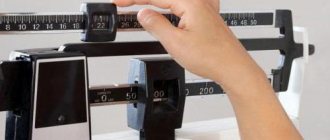Why reduce your stomach?
The main factors are excess weight and increased parameters of the organ itself, as well as:
- Lack of systematic eating, if a person eats a large amount of food, but infrequently.
- Drinking food with too much water or other drinks.
- Prolonged, dense overeating.
- Eating food in the absence of real hunger.
- The causes of increased stomach volume are anatomical.
This organ is a kind of container in which what is eaten remains for a long time, exposed to gastric juice. Then its small parts enter the duodenum, in which food is broken down and absorbed.
However, the longer the time food remains in the stomach, the more its volume increases! This should be kept in mind by anyone who wants to lose weight.
Standard stomach sizes
Normally, the volume of the human stomach occupies only 0.5 liters. At the time of eating, it can increase to 1 liter, provided that the portion eaten is large. The size of the stomach can vary slightly depending on a person's weight and height.
For reference: in obese people, the volume of the digestive organ can even reach 4 liters. And the larger its size, the stronger the feeling of hunger. This means that there is a vicious circle in which the main links are overeating and hunger.
How to reduce your stomach without surgery naturally
To limit the capacity of food “storage” without medical intervention, it is necessary to understand that the value depends on its qualities:
- Stretching occurs when food or any liquid gets into it. Thanks to his relaxation, the size increases.
- When the stomach is unloaded, it gradually decreases.
- Following this, the structure of the gastric walls changes.
- While the organ is in a compressed state, stretching to its previous size will not be rapid. To do this, a turnover of several fillings and emptyings of the stomach must occur.
- An increase in volume will not occur if the stomach, which is in a compressed state, is not overloaded.
Signs of a distended stomach
Before visiting a doctor, you cannot accurately determine whether you have a distended stomach. The first sign may be a constant feeling of fullness in the abdomen. Constant belching, complicated by nausea and vomiting, should also be of concern. In later stages, when the abdomen enlarges, the patient may begin to suffer from shortness of breath, feel nagging pain and cramps. Rarely, fever may be present.
Other unpleasant symptoms accompanying stretching of the stomach walls:
- diarrhea;
- flatulence;
- thickening of the mid-abdomen;
- quickly onset feeling of hunger;
- feeling of incomplete bowel movement.
Of course, such signs alone cannot be a reason to visit a gastroenterologist. However, if possible, it is worth talking about the unpleasant sensations at your next scheduled appointment with your therapist.
How to eat food correctly so that your stomach shrinks
The normal volume of the organ is 500-600 grams. With an ever-increasing appetite, its capacity increases to 4 liters.
1. Establish nutrition
Proper nutrition is important for losing weight! When you eat food quickly without chewing thoroughly, its amount increases significantly, but it can be reduced if you chew the food slowly. Thus, the time spent eating a small portion will not exceed 25 minutes. This is enough to make you feel full; it is during this time that food enters the digestive system.
Conversations or other activities should also not interfere with eating, to which all your attention should be directed. The stomach will “remember” the amount of food that enters it every day and its volume will gradually decrease.
2. Improve your diet
It is easier and smarter to reduce a distended stomach at home by choosing the right products. Every day's menu should include dishes containing fiber to stimulate metabolism and maintain a feeling of fullness.
3. Control the water regime
Eating right means drinking fluid in the required amount, which is 2-2.5 liters per day.
You should not drink water with your food either during or after meals. The volume of the stomach increases if liquid enters it with food.
4. Limit harmful foods
It is worth giving up sauces and fatty foods - because of them, the appetite increases and, as a result, the size of the stomach “grows” again.
Add bran to your dishes; as they swell, they fill the stomach and what you eat takes longer to digest, which allows you to forget about the feeling of hunger for a longer time.
5. Liquid diet
This proven method is recommended by many experienced nutritionists. For two days a week, for example, one day on the weekend, and the second in the middle of the week, do not eat solid food, only liquid food.
Drink fruit and vegetable juices, kefir, water and herbal tea without sugar every 2 to 3 hours. On the rest of the week, eat low-calorie meals. On other days, follow a low-calorie diet. In just 1 week you will feel the result, lightness will appear, and your stomach will tighten.
6. Reduce portions
To eat less, choose small plates and portions the size of two fists. Do not exceed this volume.
The capacity of the stomach can be determined by putting 2 fists together, and the required portion of food can fit in two palms. This is the amount of food you can eat at once.
7. Eat slowly , chewing thoroughly for at least 20 minutes.
The main causes of stomach distension
There are many diseases that are complicated by stretching of the stomach walls. However, most often the reason for the increase in the volume of the main organ of the gastrointestinal tract is the constant consumption of large amounts of foods high in fiber, as well as legumes, which provoke active production of intestinal gas. Pathological aerophagia (swallowing air) is also one of the most common causes of stomach distension. In some cases, the pathological symptom occurs due to milk or lactose intolerance, food poisoning, parasitic infections, peptic ulcers, celiac disease.
Cirrhosis and heart failure can also cause the walls to stretch. In both of these conditions, fluid accumulates in the abdomen (ascites), which creates a feeling of fullness. Thus, to the question “is it possible to stretch the stomach with water?” a positive answer is given. It’s just that water does not enter the body from the outside, but accumulates from the inside, stretching the abdominal cavity.
Other pathological causes of a distended stomach:
- intestinal diseases (irritable bowel syndrome, ulcerative colitis, Crohn's disease, persistent constipation, functional dyspepsia);
- taking certain types of medications, including antispasmodics and antidepressants;
- acute pancreatitis;
- diverticulitis;
- cystic fibrosis;
- stomach stones;
- eosinophilic gastroenteritis;
- peritonitis;
- malabsorption syndrome;
- fascioliasis;
- hernia;
- cancer diseases.
Naturally, one can only suspect gastric distension on one’s own. Only an image will allow the doctor to assess the size of the main organ of the gastrointestinal tract.
Adjust volume with exercise
By performing a simple set of exercises you will solve the problem of a large stomach quickly enough. Not only restore your metabolism, but also improve your physical performance and tighten your figure. It is important to remember that you need to exercise strictly on an empty stomach!
- While standing, inhale, then exhale, holding your breath and drawing in your stomach. Do 30 reps.
- Lying on the floor with the lower back pressed against it. Knees bent, feet on the floor, hips in line. At 2 digits, pull in your stomach while inhaling. Exhale while leaving your stomach drawn in. Do 10 repetitions, pulling your stomach in as far as possible.
- When sitting in the “half lotus” position, keep your back extremely straight! Inhaling and exhaling, “pull” the stomach towards the spine.
- Get into a plank position, resting on your palms and toes, forming a straight line. Inhale sharply, sucking in your stomach, and exhale slowly. Do it 10 times.
Exercise will reduce volume and it will be easier to consume less food.
Operations
Surgical intervention should be resorted to only if other methods have failed, your weight is more than 100 kg, and only as prescribed by a doctor.
Options for stomach reduction surgery:
- Placing a silicone balloon in the stomach , partially filling it, which allows you to get full in a shorter period of time. Thanks to this, the patient is able to successfully lose weight. The balloon is used for 6–12 months, then it is removed. This procedure is no more complicated than gastroscopy.
- A laparoscopic bandage is placed on the very top of the organ to reduce the amount of food that gets into it. The intervention during this procedure is minimal and is limited to several miniature holes in the abdominal cavity. The size of the bandage is adjustable.
- Gastrobypass surgery is the isolation of the upper gastric part from the lower part. The resulting “mini-stomach” is attached to the jejunum. The result of the procedure is a significant reduction in the amount of food entering the stomach.
- When performing a biliopancreatic bypass, part of the organ is removed and the duodenum is cut off from it, replacing it with an attached part of the jejunum. In addition, the gallbladder is removed to prevent the formation of stones in it. After the operation, the new tiny food “storage” holds no more than 120 ml of food.
How to lose weight by 15 kg
Losing 15 kg is the dream of many beautiful ladies. Trying to get back as quickly as possible...
Useful video
Exercises to reduce stomach volume are given in this video.
Nutritional Features
People who know for sure that their stomach will become distended due to overeating should make drastic changes to their diet. You will also have to avoid certain types of food. Certain types of foods aggravate the problem of a distended gastrointestinal tract.
Food that takes a long time to digest is excreted into the large intestine almost unchanged, where it continues to decompose, producing large amounts of gas. Excessive consumption of foods with a lot of fiber can also cause stretching of the stomach walls. In particular, you should avoid broccoli, legumes and cabbage.
When you feel hungry, it is better to drink a glass of water first. It is likely that the body does not want to eat, but drink. And those who are worried about whether the stomach is stretched from water should remember: the accumulation of abdominal fluid is dangerous. And if you drink water in small portions of 200-300 ml at a time, then you don’t have to worry about any sprains.
Special therapeutic exercises
Proper nutrition and exercise go hand in hand. To reduce the size of the stomach, it is important to devote at least an hour a day to exercise therapy. Basically, the load is designed to strengthen the abdominal muscles. The muscle corset will set some boundaries for the stomach.
The best exercise is to raise the body to the knees. You need to lie on your back, raise your knees and start pumping your abs. To work the oblique muscles, you need to reach your right elbow towards your left knee, and vice versa. People with a high level of physical fitness can additionally perform the “scissors” exercise. You need to lie on your back, raise your legs and start crossing them.
Surgical intervention
Stomach reduction surgery was carried out for a long time according to strict indications. But in private clinics, gastrectomy is touted as a "quick fix" for those who don't have the desire or discipline to reduce their stomach size through fasting, healthy eating and exercise.
During a partial gastrectomy, up to 80 percent of the top of the stomach is removed. It is the upper part of the stomach that is intended for storing food, but the lower part plays the role of a meat grinder, after which the remains of semi-processed food are sent to the intestines. If after surgery the patient does not begin to eat in old portions, then all food ingested will be quickly digested.
In fact, after surgery, the feeling of fullness comes faster, so (unless overeating was associated with mental or psychological problems) reverse distension of the stomach is very unlikely.
Are such operations dangerous?
Most people who want to lose weight, but do not know about other ways to narrow the stomach and reduce appetite, tend to undergo surgery at the first opportunity. However, any surgical procedure has specific dangers. For this reason, doctors always notify about side effects.
It should be noted that after any type of operation, medical supervision will be required.
Taking vitamin and mineral dietary supplements, as well as a special diet, will be for life! Therefore, before resorting to such drastic weight loss measures, it is important to evaluate all the positive and negative aspects so as not to suffer from serious consequences in the future.
Tablets to reduce stomach
It is not recommended to take such drugs on your own. They are prescribed only by a doctor. These remedies do not so much help to shrink the stomach as they suppress appetite. But they have a very negative impact on human health, so experts do not recommend taking them. Here are just a few facts indicating the dangers of such products:
- Negative effects on the nervous system, leading to sleep disturbances, apathy, depression and irritability.
- Metabolic disorders leading to hair loss and deterioration of skin condition.
- Irritation of the mucous membranes of the stomach and intestines.
- The appearance of diarrhea.
- Quick return of lost kilograms.
The only positive effect of such drugs is a decrease in appetite; a significant reduction in the stomach without surgery using these drugs is impossible. Doctors sometimes prescribe them, but in this case the pills are taken under the supervision of a specialist, and the duration of the course is also set by him. Such measures are taken to treat extreme obesity, because a person with a similar diagnosis often simply cannot control his appetite.
Benefits of adjusting the digestive system
Not everyone who wants to lose excess weight knows how to make their stomach volume smaller, so they limit the amount of food they eat as much as possible or, worst of all, start using “magic” pills and other dietary supplements that supposedly will help achieve what they want, while you can adjust the size in completely safe ways - exercise and proper nutrition!
When the stomach decreases in volume, the following beneficial changes occur:
- The process of digesting food returns to normal due to the fact that less food gets into it and its absorption occurs more efficiently.
- Weight is reduced and metabolism is restored.
- The likelihood of diabetes is significantly reduced.
- Gastritis and ulcers are successfully treated.
- General well-being improves, activity increases, and immunity increases.
As for surgical interventions, this is an option only for the most hopeless cases.











